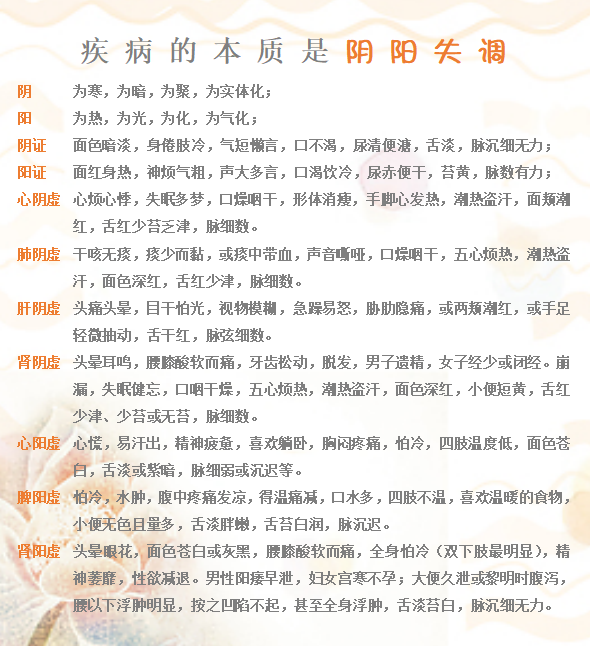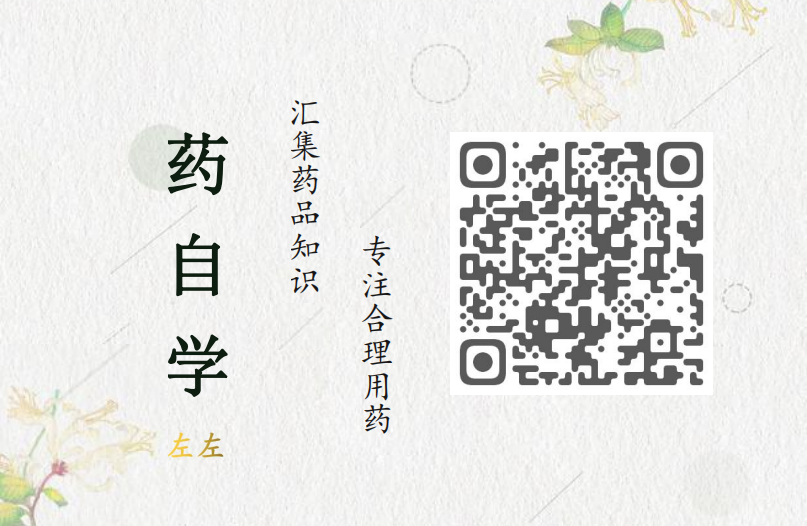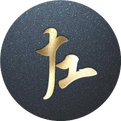 In the diagnosis of diseases, we often discuss Yin deficiency or Yang deficiency, specifically relating to certain organs such as Shen Yin Xu (Kidney Yin Deficiency), Shen Yang Xu (Kidney Yang Deficiency), Gan Yin Bu Zu (Liver Yin Deficiency), and Gan Yang Shang Kang (Liver Yang Excess). What are the conditions of Yin-Yang imbalance?Yin-Yang imbalance occurs during the development of diseases, where various pathogenic factors disrupt the balance of Yin and Yang in the body. It also encompasses the disharmony of organs, meridians, and the Qi and Blood systems.Pathogenic Qi can be classified into Yin and Yang types, while Zheng Qi (Upright Qi) also has Yin and Yang components. When Yang pathogenic factors invade the body, Yin Qi rises to resist; conversely, when Yin pathogenic factors invade, Yang Qi rises to resist.Yang ExcessThe general causes of Yang Excess include external factors such as exposure to warm and hot Yang pathogens, like Shu (Summer Heat), Re (Heat), and Huo (Fire); and internal factors such as Qi stagnation, Blood stasis, food accumulation, or emotional distress leading to internal heat.Yang Qi has warming, promoting, and stimulating functions, and in disease presentations, it often shows characteristics of heat, movement, and dryness, such as high fever, thirst, flushed face, yellow urine, constipation, red tongue with yellow coating, and rapid pulse.When Yang is excessive, it can damage Yin. Initially, the damage to Yin and body fluids by Yang Qi is not obvious, presenting as a pattern of excess heat; as the condition progresses, Yang Qi significantly depletes Yin and body fluids, leading to a presentation of excess heat and Yin deficiency with fluid depletion; if Yin is severely damaged, it results in a pattern of false heat.Yin ExcessThe general causes of Yin Excess include exposure to cold pathogens, damp pathogens, or obstruction by cold, and excessive consumption of raw and cold foods, leading to a pathological state of suppressed function and excessive heat consumption.Yin Qi has cooling, moistening, suppressing, and calming functions, and in disease presentations, it often shows characteristics of cold, stillness, and dampness, such as cold limbs, preference for curling up and sleeping, pale and moist tongue, and slow pulse.
In the diagnosis of diseases, we often discuss Yin deficiency or Yang deficiency, specifically relating to certain organs such as Shen Yin Xu (Kidney Yin Deficiency), Shen Yang Xu (Kidney Yang Deficiency), Gan Yin Bu Zu (Liver Yin Deficiency), and Gan Yang Shang Kang (Liver Yang Excess). What are the conditions of Yin-Yang imbalance?Yin-Yang imbalance occurs during the development of diseases, where various pathogenic factors disrupt the balance of Yin and Yang in the body. It also encompasses the disharmony of organs, meridians, and the Qi and Blood systems.Pathogenic Qi can be classified into Yin and Yang types, while Zheng Qi (Upright Qi) also has Yin and Yang components. When Yang pathogenic factors invade the body, Yin Qi rises to resist; conversely, when Yin pathogenic factors invade, Yang Qi rises to resist.Yang ExcessThe general causes of Yang Excess include external factors such as exposure to warm and hot Yang pathogens, like Shu (Summer Heat), Re (Heat), and Huo (Fire); and internal factors such as Qi stagnation, Blood stasis, food accumulation, or emotional distress leading to internal heat.Yang Qi has warming, promoting, and stimulating functions, and in disease presentations, it often shows characteristics of heat, movement, and dryness, such as high fever, thirst, flushed face, yellow urine, constipation, red tongue with yellow coating, and rapid pulse.When Yang is excessive, it can damage Yin. Initially, the damage to Yin and body fluids by Yang Qi is not obvious, presenting as a pattern of excess heat; as the condition progresses, Yang Qi significantly depletes Yin and body fluids, leading to a presentation of excess heat and Yin deficiency with fluid depletion; if Yin is severely damaged, it results in a pattern of false heat.Yin ExcessThe general causes of Yin Excess include exposure to cold pathogens, damp pathogens, or obstruction by cold, and excessive consumption of raw and cold foods, leading to a pathological state of suppressed function and excessive heat consumption.Yin Qi has cooling, moistening, suppressing, and calming functions, and in disease presentations, it often shows characteristics of cold, stillness, and dampness, such as cold limbs, preference for curling up and sleeping, pale and moist tongue, and slow pulse.
When Yin is excessive, it can damage Yang. Therefore, when Yin is excessive, there is often a deficiency of Yang Qi, forming a pattern of excess cold with Yang deficiency; if Yang is severely damaged, it transitions from excess to deficiency cold.

The body’s Zheng Qi consists of both Yin and Yang Qi. If there is a reduction or functional decline in either Yin or Yang Qi, it cannot restrain the other, leading to relative excess of the opposing force.
Yang Deficiency
Yang Deficiency generally has several causes, such as congenital insufficiency, lack of nourishment postnatally, internal injury from overwork, or prolonged illness damaging Yang, leading to reduced or weakened body function, slow metabolism, and insufficient heat production.The warming, promoting, and stimulating functions of Yang Qi are diminished, thus often presenting with cold symptoms, such as aversion to cold, cold limbs, phlegm and dampness, lack of energy, cold pain in the abdomen, clear and prolonged urination, and pale tongue with slow pulse.The distinction between Yang Deficiency and cold due to Yin Excess lies in the former being primarily a deficiency with cold, while the latter is primarily cold with less obvious deficiency symptoms.Yin DeficiencyYin Deficiency generally arises from Yang pathogens damaging Yin, excessive emotional stress transforming into fire and injuring Yin, or prolonged illness damaging Yin, leading to relatively accelerated metabolism, increased heat production, and hyperfunction of the body.The cooling, moistening, suppressing, and calming functions of Yin Qi are diminished, thus presenting with symptoms of false heat or hyperfunction, such as five hearts heat, tidal fever, flushed cheeks, low-grade fever with night sweats, red tongue with little coating, and thin rapid pulse.The distinction between Yin Deficiency and heat due to Yang Excess lies in the former being primarily a deficiency with heat, while the latter is primarily heat with less obvious deficiency symptoms.Mutual Damage of Yin and YangIn addition to the excess and deficiency of Yin and Yang, there is also mutual damage between them. Yin and Yang are interdependent and mutually nourishing; the development of Yin deficiency can lead to Yang deficiency, and vice versa, resulting in both Yin and Yang deficiency.For example, Gan Yang Shang Kang (Liver Yang Excess) is primarily due to Liver and Kidney Yin deficiency, where Yin cannot restrain Yang, leading to relative excess of Yang. However, as the condition progresses, it can affect Kidney Yang, resulting in symptoms of cold limbs, pale complexion, etc., indicating Kidney Yang deficiency.Yin Excess Resisting YangWhen Yin Qi is too excessive, cold accumulates internally, pushing Yang Qi outward, resulting in pale complexion, cold limbs, aversion to cold, and curling up, along with signs of false heat such as flushed face and thirst. This is termed true cold with false heat syndrome.Yang Excess Resisting YinWhen Yang Qi is too excessive, heat accumulates internally, pushing Yin Qi outward, resulting in flushed face, high fever, coarse breathing, red tongue, and rapid pulse, along with signs of false cold such as cold limbs and hidden pulse. This is termed true heat with false cold syndrome.Loss of Yin and YangThis is the most severe condition and poses a life-threatening pathological state, including loss of Yang and loss of Yin.Loss of Yang is often due to excessive sweating, persistent vomiting and diarrhea, overexertion, or prolonged illness damaging Yang, leading to significant loss of Yang Qi, presenting with profuse cold sweat, palpitations, shortness of breath, pale complexion, cold limbs, and mental fatigue.Loss of Yin is often due to excessive heat pathogens, prolonged heat damaging fluids, or fluid leakage, leading to significant consumption of Yin Qi, presenting with continuous sweating, agitation, palpitations, fatigue, and other critical symptoms.Although the situations of Yin-Yang imbalance are complex, the most fundamental aspect is the excess or deficiency of Yin and Yang. When we self-regulate diseases, the primary judgment is whether it is an excess syndrome or deficiency syndrome, a heat syndrome or cold syndrome.

How do the body’s Zheng Qi and Xie Qi (Evil Qi) combat each other?
There are many types of diseases; diagnosis should precede treatment.
The Chinese and Western medicines and formulas mentioned in this article should be used under the guidance of professionals.
TCM enthusiasts can join the discussion group on the public account homepage.


